
Spool knitters with more than 4 posts can easily be used to create flat knitted pieces.
The trick to this technique is to not go all the way around the spool knitter and go back and forth instead.
Starting with the basic technique from how to spool knit, begin wrapping the yarn around the posts, stopping when you get to the last one. Wrap the yarn around the last peg a second time and begin stitching around the knitter back to the first post. After making a stitch on the first post, wrap the yarn around the post and make a second stitch and begin working your way back across. You need to make two stitches on the first and last post because you need to both finish one row and start the next from that same post.
This spool knitting technique is a little awkward for the first few rows when you are working with the first and last pegs but once you get a few rows done it becomes easier to keep the loops on the posts. To keep the stitches tight, push your knitted piece down through the spool.
|
|
When your flat spool knit web is the desired length, cut the yarn and run it through the loops on the peg the same way as you would when using the basic spool knitting technique. Pull the yarn only as tight as the knit piece is wide otherwise your piece will curl. |
|
|
To keep your flat spool knit web flat, you will need to do one additional step to secure the end. Using a crochet hook or working carefully with your fingers, loop the tail over the thread that was run through each of the loops that had been on the pegs and a loop from the last finished row.Weave the end in a bit more to ensure it won’t unravel. Do not immediately cut the tail as it may be useful when making something from your spool knit flat web. |
Spool knit flat web will curl at the edges when you first remove it from the knitting spool. With a bit of patience, you can get it to lay flat by gently twisting the edges to shift the stitches into a flat position.
This spool knitting technique makes a soft and flexible piece. The stitches are big and gappy and are easily shifted out of shape (not permanently) so this technique may not be the best choice for all projects.
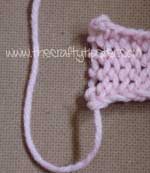
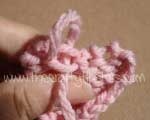
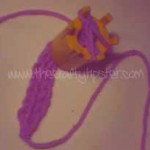
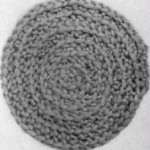
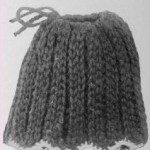
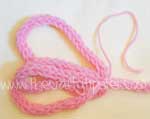
I just learned something tonight….thank you very much!
You are most welcome! Thank you for letting me know.